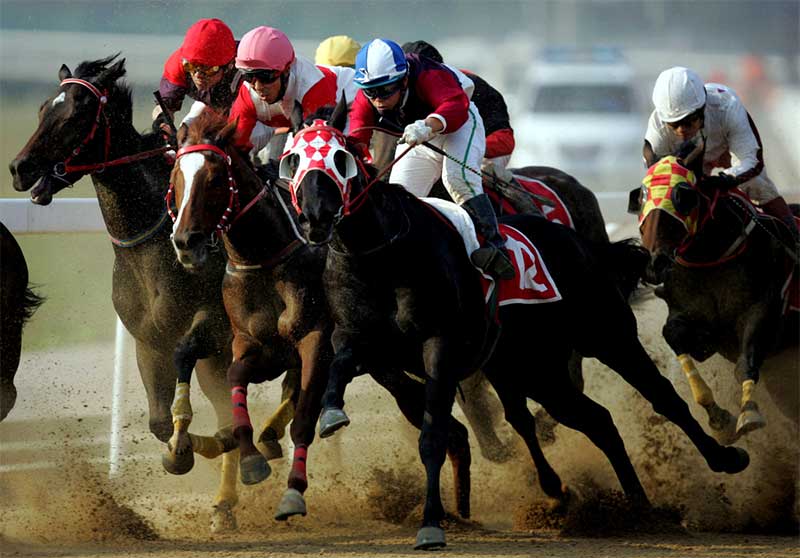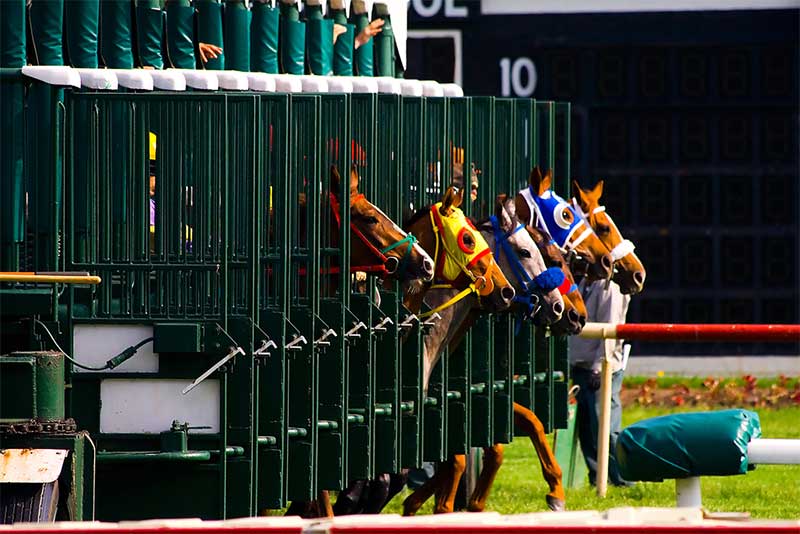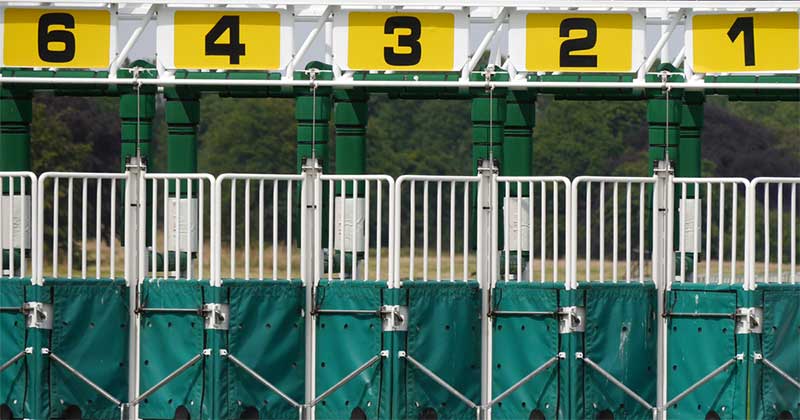It depends on the context. A martingale can be equine equipment or a betting system. It can also be a positive progression trading strategy used in the financial markets.
Uses of a Martingale in Horse Riding and Training
A martingale is also a piece of equine equipment used in horse riding. It is a strap that attaches to the girth of the horse’s saddle and runs down to the reins. There are two main types of martingales: the running martingale and the standing martingale.
A running martingale:
This type of training aid is used to help a horse maintain a more vertical head position while being ridden. It consists of a rein attached to the saddle’s girth and runs down to the bit. The idea is that when the horse raises its head too high, the running martingale will apply tension to the reins, and the pressure encourages the horse to bring its head back down to a more desirable position.
A standing martingale:
A standing martingale is similar to the running counterpart, but instead of running down to the bit, it attaches to the girth of the saddle and then splits into two separate reins that run down to the bit on either side of the horse’s neck. This type of martingale is designed to help a horse keep its head in a more upright position and to discourage it from tossing its head too high.

Both types of martingales are often used as training aids for inexperienced or young horses. They can also be used for riding or training horses that have a tendency to lift their heads too high while being ridden. Most riders don’t use them in competition.
Uses of the Martingale in Betting
In the context of gambling, a martingale is a betting strategy that involves increasing the amount of the next bet whenever the previous bet has been lost. The idea behind this strategy is that by doubling the bet after each loss, the player will eventually win and recoup all of their previous losses.
For example, if a roulette player were to bet $10 on red and lose, they would wager $20 on the next spin in an attempt to win back the $10 that they lost. If they lose again, they would bet $40 on the next spin, and so on.
The idea is that eventually the player will win, and the winnings will be enough to recoup all the losses and earn a profit equal to the initial wager.
In betting, the Martingale system is used as a way to try to increase the chances of winning by increasing the size of the bets after each loss. It’s often used in casino games that involve even money bets, such as roulette or craps.
The Uses of Martingale in the Financial Markets
Although the Martingale strategy is commonly applied to gambling, it can also be used in trading. The strategy involves increasing the amount of your next trade after a loss, so that the first winning trade would recover all previous losses plus a profit equal to the original investment. It has been used in financial markets in an attempt to profit from short-term price movements.

For example, a trader might use the Martingale system to trade a financial instrument like FOREX, stock, or commodity prices that they believe is undervalued. If the price of the instrument falls after the trader has bought it, they might increase their position by buying more of the instrument, in the hope that the price will eventually rise and they will be able to sell at a profit.
What is the difference between a standing martingale and a running martingale?
A standing martingale is a piece of equipment used in horse riding that is designed to help a horse keep its head in a more upright position and to discourage it from tossing its head too high.
It consists of a stop rein that is attached to the girth of the saddle and then splits into two separate reins that run down to the bit on either side of the horse’s neck.
Jockeys use standing martingales to prevent the horse from tossing its head back and hurting them. However, you won’t see it in use at cross-country or race-track horse racing events. This is because it puts pressure on the cavesson nose and makes it too restrictive for long events.
A running martingale is also a training aid that is used to help a horse maintain a more vertical head position while being ridden. It consists of a rein that is attached to the girth of the saddle and runs down to the bit.
In case your horse tosses its head higher than you’d like, the running martingale applies pressure to the reins and encourages the horse to bring its head back down to a more desirable position.

To properly adjust a running martingale, the forks should have about an inch of slack when the horse holds its head in a natural position. When the running martingale is not being used and the horse’s head is at the desired height, the reins should form a straight line from the rider’s hand to the bit ring.
The main difference between a standing martingale and a running martingale is the way that they are attached to the reins. A standing martingale splits into two separate reins that run down to the bit on either side of the horse’s neck, while a running martingale consists of a single rein that runs down to the bit.
Other differences between a standing and a running martingale are as follows:
Adjustability: Standing martingales are generally more adjustable than running martingales. They usually have a series of rings or slots that allow the reins to be shortened or lengthened, which can be useful for fine-tuning the amount of pressure that is applied to the horse’s neck. Running martingales, on the other hand, often have a single adjustment point where the rein attaches to the girth of the saddle, which allows for less precision in terms of the amount of pressure that is applied.
Effect on the movement of the horse: Because standing martingales apply pressure to the reins on either side of the horse’s neck, they can potentially affect the horse’s ability to flex at the poll (the top of the neck). This could make it more difficult for the horse to turn or change direction smoothly.
Running martingales, on the other hand, do not apply pressure to the reins on either side of the neck, so they are less likely to interfere with the horse’s movement in this way.
Purpose: Both types of martingales are used as training aids to help a horse maintain a more vertical head position while being ridden, but they work in slightly different ways. A standing martingale is designed to help a horse keep its head in a more upright position and to discourage it from tossing its head too high, while a running martingale is intended to apply pressure to the reins and encourage the horse to bring its head back down to a more desirable position when it raises its head too high.

Use in competition: Standing martingales are allowed in many types of competition, while running martingales are generally not permitted. This is because standing martingales are considered to be a relatively mild form of training aid that does not significantly alter the horse’s natural head position, while running martingales are thought to be more intrusive and could potentially be used to cover up other problems or training issues.
Martingale FAQs
When should you use a martingale?
A martingale is a training tool that can be used to help a horse maintain a more vertical head position while being ridden. It’s commonly used with young or inexperienced horses, or with specimens that tend to lift their heads too high while you ride them. Martingales can be helpful for promoting good head carriage and encouraging a horse to accept contact with the bit.
However, they shouldn’t be used as a substitute for proper training or completely relied upon to correct serious problems with the horse’s head position and contact with the bit. It’s not a quick fix. Instead, you should use it sparingly to complement the work of a qualified trainer and only as a training aid.
That being said, a martingale can be quite helpful during certain types of work, such as flatwork or dressage. But it is neither necessary nor appropriate to use a martingale during every ride.
Should I use a running or standing martingale?
The choice between using a running or standing martingale depends on your goals as a rider and the discipline you are participating in. In show hunter competitions, standing martingales are typically required, even for horses that don’t necessarily need them, as they are considered part of the “look” of the horse.

However, for most riders, the decision to use a martingale at all is based on function. Both running and standing martingales are used to control the height at which a horse carries its head, with the goal of preventing the rider from being struck in the face if the horse throws its head too high.
It’s important to note that some riders may adjust the martingale to achieve a specific head position, but this can restrict the horse’s ability to use its neck for balance. While both types of martingales serve the same purpose, they work in different ways to achieve it.
Standing Martingale – When and When Not to Use It
The standing martingale is a strap that connects the noseband to the girth or breastplate of the horse’s saddle. The noseband is designed to help the rider control the position of the horse’s head by applying pressure to the nose. Adjust the martingale to ensure the reins have at least one inch of slack when the head of your horse is in a neutral, relaxed position and the strap fits comfortably under the horse’s throat latch.
This type of martingale is particularly useful for horses that tend to invert their necks and toss their heads excessively.
One of the main benefits of the standing martingale is that it is a self-correcting device that is activated by the horse’s movements – it is passive. Once the “correction” has been made, the martingale releases and no longer has any influence.
Note, however, standing martingale can be more dangerous than a running martingale because it can be more restrictive in certain situations. For one thing, the standing martingale is a type of horse riding equipment that cannot be easily released and may cause harm if the horse falls or gets a leg caught. As a result, it is not permitted at tournaments like the British eventing events due to the potential danger it poses.
Running Martingale – When and When Not to Use It
The running martingale is a more complex piece of equipment. It attaches to the stop reins from the breastplate or girth. It’s designed to enhance leverage to the bit when you’re pulling the reins. The rings of the martingale pull down, applying pressure to the bars of the horse’s mouth.
One negative aspect of the running martingale is that the reins are constantly being pulled owing to the correct weight unless you’re allowing the reins to be loose. Because of this, many riders opt not to use a running martingale in conjunction with a leverage bit like a gag or elevator and instead attach the rings to the snaffle rein on a pelham.
While running martingales are less restrictive than standing martingales and are considered by some to be safer (they can be used in British eventing events, for example), it is important to use rein stops to prevent the rings from slipping down and getting caught on the bit. Accidents can occur if the bit becomes caught in a ring.

Most equine lovers hunt with a running martingale because they appreciate the extra leverage it provides. It allows them to use a milder bit and helps keep their horse’s head in a more upright position when the horse becomes excited. Most people rarely use a running martingale for other types of riding.
Why do hunters use a standing martingale?
Hunters often use standing martingales for a variety of reasons, including:
- To help a horse maintain a more upright head position while jumping, improving balance and technique
- To encourage a horse to keep its head in a more desirable position by applying pressure to the reins on either side of the neck. It helps serve as a neck strap.
- As a training aid to help a horse develop better head carriage and a more correct, vertical head position
- For safety, to prevent the reins from becoming tangled or caught on objects in the environment.
- To help a horse develop more consistent contact with the bit
- To help prevent a horse from leaning on the bit or pulling against the reins
- To help a horse learn to accept the bit more willingly
Why would you use a standing martingale?
There are many reasons why you might want to use a standing martingale. One reason might be to help a horse maintain a more upright head position while jumping, which can improve balance and technique. A standing martingale can also be helpful for horses that have a tendency to lift their heads too high while being ridden, as it applies pressure to the reins on either side of the horse’s neck and encourages the horse to keep its head in a more desirable position.
Standing martingales can also be used as a training aid to help a horse develop better head carriage and a more correct, vertical head position.
They are often used with young or inexperienced horses, or with horses that have a tendency to lean on the bit or pull against the reins.

In addition to these training and positioning benefits, standing martingales may also be used for safety reasons. Because they attach to the reins on either side of the horse’s neck, they can help prevent the reins from becoming tangled or caught on objects in the environment, which could potentially cause the horse to trip or fall.
How does a running martingale work?
A running martingale is a piece of equipment used in horse riding that is designed to help a horse maintain a more vertical head position while being ridden. It consists of a rein that is attached to the girth of the saddle and runs down to the bit. The running martingale applies pressure to the reins and encourages the horse to bring its head back down to a more desirable position.
To use a running martingale, the rider first attaches the rein to the girth of the saddle. The rein then runs down to the bit, passing through the rings of the martingale as it goes. Whenever your ride pushes its head too high, the rings of the martingale pull down on the reins, applying pressure to the bars of the horse’s mouth and encouraging the horse to bring its head back down to a more vertical position.
When using a running martingale, it is important to ensure that the reins have at least one inch of slack when the head of your horse is neutrally positioned. This will allow the horse to move its head freely and will prevent the martingale from applying too much pressure to the reins.
